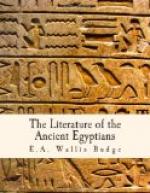There is reason to think that the three sons of Rut-tetet became the three kings of the fifth dynasty who were known by the names of Khafra, Menkaura, and Userkaf. The stories given above are valuable because they contain elements of history, for it is now well known that the immediate successors of the fourth dynasty, of which Khufu, Khafra, and Menkaura, the builders of the three great pyramids at Gizah, were the most important kings, were kings who delighted to call themselves sons of Ra, and who spared no effort to make the form of worship of the Sun-god that was practised at Anu, or Heliopolis, universal in Egypt. It is probable that the three magicians, Ubaaner, Tchatchamankh, and Teta were historical personages, whose abilities and skill in working magic appealed to the imagination of the Egyptians under all dynasties, and caused their names to be venerated to a remote posterity.
CHAPTER IV
THE BOOK OF THE DEAD
“Book of the Dead” is the name that is now generally given to the large collection of “Chapters,” or compositions, both short and long, which the ancient Egyptians cut upon the walls of the corridors and chambers in pyramids and rock-hewn tombs, and cut or painted upon the insides and outsides of coffins and sarcophagi, and wrote upon papyri, etc., which were buried with the dead in their tombs. The first modern scholar to study these Chapters was the eminent Frenchman, J. Francois Champollion; he rightly concluded that all of them were of a religious character, but he was wrong in calling the collection as a whole “Funerary Ritual.” The name “Book of the Dead” is a translation of the title “Todtenbuch,” given by Dr. R. Lepsius to his edition of a papyrus at Turin, containing a very long selection of the Chapters,[1] which he published in 1842. “Book of the Dead” is on the whole a very satisfactory general description of these Chapters, for they deal almost entirely with the dead, and they were written entirely for the dead. They have nothing to do with the worship of the gods by those who live on the earth, and such prayers and hymns as are incorporated with them were supposed to be said and sung by the dead for their own benefit. The author of the Chapters of the Book of the Dead was the god Thoth, whose greatness has already been described in Chapter I of this book. Thus they were considered to be of divine origin, and were held in the greatest reverence by the Egyptians at all periods of their long history. They do not all belong to the same period, for many of them allude to the dismemberment and burning of the dead, customs that, though common enough in very primitive times, were abandoned soon after royal dynasties became established in Egypt.
[Footnote 1: The actual number of Chapters in this papyrus is 165.]




